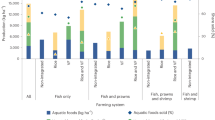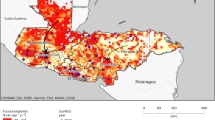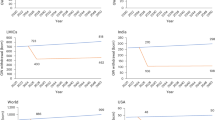Abstract
The interaction between climate change and agricultural intensification contributes to biodiversity loss, while widespread degradation of land and water undermine food system productivity. Agroecological principles aim to guide food systems transformation but rarely refer to water or aquatic foods, which are critical elements of nutritious, sustainable and equitable food systems. Here we examine the principles and frameworks presented in agroecological literature and suggest rephrasing of six of the principles to incorporate water, aquatic foods and land- to seascapes. We recommend three cross-sectoral actions that leverage aquatic features in agroecosystems to facilitate more effective transition pathways towards sustainable food systems.
This is a preview of subscription content, access via your institution
Access options
Access Nature and 54 other Nature Portfolio journals
Get Nature+, our best-value online-access subscription
$32.99 / 30 days
cancel any time
Subscribe to this journal
Receive 12 digital issues and online access to articles
$119.00 per year
only $9.92 per issue
Buy this article
- Purchase on SpringerLink
- Instant access to full article PDF
Prices may be subject to local taxes which are calculated during checkout

Similar content being viewed by others
Change history
18 April 2025
In the version of this article initially published, the Acknowledgements did not include thanks from Edward Hugh Allison for funding from the Government of Canada’s International Climate Finance Initiative and the International Development Research Centre, Ottawa, Canada through the AQUADAPT program, as is now amended in the HTML and PDF versions of the article.
References
Gliessman, S. Defining agroecology. Agroecol. Sustain. Food Syst. 42, 599–600 (2018).
Wezel, A. et al. Agroecological principles and elements and their implications for transitioning to sustainable food systems. A review. Agron. Sustain. Dev. 40, 40 (2020).
Nyéléni, M. Declaration of the International Forum for Agroecology (International Planning Committee for Food Sovereignty, 2015).
Agroecology and Food Sovereignty in Small-Scale Fisheries (World Forum of Fisher People, 2017).
Giraldo, O. F. & Rosset, P. M. Agroecology as a territory in dispute: between institutionality and social movements. J. Peasant Stud. 45, 545–564 (2017).
Fisher, B. et al. Integrating fisheries and agricultural programs for food security. Agric. Food Secur. 6, 10–16 (2017).
Gerten, D. et al. Feeding ten billion people is possible within four terrestrial planetary boundaries. Nat. Sustain. 3, 200–208 (2020).
The State of World Fisheries and Aquaculture 2022: Towards Blue Transformation (FAO, 2022); https://doi.org/10.4060/cc0461en
Naylor, R. L. et al. Blue food demand across geographic and temporal scales. Nat. Commun. 12, 5413 (2021).
Atapattu, S. S. & Kodituwakku, D. C. Agriculture in South Asia and its implications on downstream health and sustainability: a review. Agric. Water Manag. 96, 361–373 (2009).
Levard, L., Mathieu, B. & Masse, P. Handbook for the Evaluation of Agroecology: A Method to Evaluate its Effects and the Conditions for its Development (GTAE AgroParisTech CIRAD IRD, 2019).
TAPE Tool for Agroecology Performance Evaluation 2019: Process of Development and Guidelines for Application (FAO, 2019); https://www.fao.org/agroecology/tools-tape/howitworks/en/
Tools (Biovision, 2019); https://www.agroecology-pool.org/tools/
Loring, P. A. Can fisheries be “regenerative”? Adapting agroecological concepts for fisheries and the blue economy. FACETS 8, 1–6 (2023).
Basurto, X. et al. A global assessment of preferential access areas for small-scale fisheries. npj Ocean Sustain. 3, 56 (2024).
Vanni, M. J. Nutrient cycling by animals in freshwater ecosystems. Annu. Rev. Ecol. Evol. Syst. 33, 341–370 (2002).
Gentry, R. R. et al. Exploring the potential for marine aquaculture to contribute to ecosystem services. Rev. Aquac. 12, 499–512 (2020).
Kabir, K. A. et al. Effect of dietary protein to energy ratio on performance of Nile tilapia and food web enhancement in semi-intensive pond aquaculture. Aquaculture 499, 235–242 (2019).
Nederlof, M. A. J. et al. Nutrient retention efficiencies in integrated multi-trophic aquaculture. Rev. Aquac. 14, 1194–1212 (2022).
Uhlenbrook, S. et al. Optimising the water we eat – rethinking policy to enhance productive and sustainable use of water in agri-food systems across scales. Lancet Planet. Health 6, e59–e65 (2022).
Khumairoh, U. et al. Agro-ecological mechanisms for weed and pest suppression and nutrient recycling in high yielding complex rice systems. Agric. Ecosyst. Environ. 313, 107385 (2021).
Mortillaro, J. M. et al. Trophic functioning of integrated rice–fish farming in Madagascar: insights from stable isotopes (δ13C & δ15N). Aquaculture 555, 738240 (2022).
Chapman, A. D. et al. Adaptation and development trade-offs: fluvial sediment deposition and the sustainability of rice-cropping in An Giang province, Mekong Delta. Climatic Change 137, 593–608 (2016).
Musa, M. et al. Feasibility study and potential of pond as silvofishery in coastal area: local case study in Situbondo Indonesia. Reg. Stud. Mar. Sci. 33, 100971 (2020).
Be, T. T., Dung, L. C. & Brennan, D. Environmental costs of shrimp culture in the rice‐growing regions of the Mekong Delta. Aquac. Econ. Manag. 3, 31–42 (1999).
Chowdhury, M. D. et al. Effect of combined shrimp and rice farming on water and soil quality in Bangladesh. Aquac. Int. 19, 1193–1206 (2011).
Frei, M. et al. Effects of a mixed culture of common carp, Cyprinus carpio L., and Nile tilapia, Oreochromis niloticus (L.), on terrestrial arthropod population, benthic fauna, and weed biomass in rice fields in Bangladesh. Biol. Control 41, 207–213 (2007).
Sileshi, Z., Tegegne, A. & Tsadik, G. T. in Integrated Water and Land Management Research and Capacity Building Priorities for Ethiopia (eds McCornick, P. G. et al.) 66–79 (Ethiopian Ministry of Water Resources, 2003).
Stien, L. H. et al. in The Welfare of Fish (eds Kristiansen, T. S. et al.) 303–321 (Springer, 2020).
Strayer, D. L. & Dudgeon, D. Freshwater biodiversity conservation: recent progress and future challenges. J. N. Am. Benthol. Soc. 29, 344–358 (2010).
Tickner, D. et al. Bending the curve of global freshwater biodiversity loss: an emergency recovery plan. BioScience 70, 330–342 (2020).
Freed, S. et al. Rice field fisheries: wild aquatic species diversity, food provision services and contribution to inland fisheries. Fish. Res. 229, 105615 (2020).
Ward, N. D. et al. Where carbon goes when water flows: carbon cycling across the aquatic continuum. Front. Mar. Sci. 4, 7 (2017).
McCartney, M. & Nyambe, I. A. in The Zambezi River Basin (eds Lautze, J. et al.) 125–157 (Routledge, 2017).
Lo, M., Narulita, S. & Ickowitz, A. The relationship between forests and freshwater fish consumption in rural Nigeria. PLoS ONE 14, e0218038 (2019).
Freed, S. et al. Maintaining diversity of integrated rice and fish production confers adaptability of food systems to global change. Front. Sustain. Food Syst. 4, 576179 (2020).
Kaminski, A. M. et al. A review of inclusive business models and their application in aquaculture development. Rev. Aquac. 12, 1881–1902 (2020).
Belton, B., Ahmed, N. & Murshed-e-Jahan, K. Aquaculture, Employment, Poverty, Food Security and Well-Being in Bangladesh: A Comparative Study (CGIAR Research Program on Aquatic Agricultural Systems, 2014).
Kim, M. et al. A Manual for Community Fish Refuge-Rice Field Fisheries System Management in Cambodia (Fisheries Administration & WorldFish Cambodia, 2019).
Allison, E. H. et al. in The Blue Compendium: From Knowledge to Action for a Sustainable Ocean Economy (eds Lubchenco, J. & Haugan, P. M.) 393–443 (Springer, 2023).
Namafe, C. M. Flooding in the context of the Barotse people of the upper Zambezi wetlands. South. Afr. J. Environ. Educ. 21, 50–60 (2004).
Stacey, N. et al. in Social Wellbeing and the Values of Small-Scale Fisheries (eds Johnson, D. S. et al.) 97–123 (Springer, 2018).
Cisneros-Montemayor, A. M. et al. A global estimate of seafood consumption by coastal Indigenous peoples. PLoS ONE 11, e0166681 (2016).
Bryan, E. et al. Adapting agriculture to climate change in Kenya: household strategies and determinants. J. Environ. Manag. 114, 26–35 (2013).
Lefore, N. et al. Sustainable and equitable growth in farmer-led irrigation in sub-Saharan Africa: what will it take? Water Altern. 12, 156–168 (2019).
Duncan, N. et al. Fish for whom?: Integrating the management of social complexities into technical investments for inclusive, multi-functional irrigation. World Dev. Perspect. 22, 100318 (2021).
Woodhouse, P. et al. African farmer-led irrigation development: re-framing agricultural policy and investment? J. Peasant Stud. 44, 213–233 (2017).
Voluntary Guidelines for Securing Sustainable Small-Scale Fisheries (FAO, 2015).
Allison, E. H. & Mills, D. J. Counting the fish eaten rather than the fish caught. Proc. Natl Acad. Sci. USA 115, 7459–7461 (2018).
Olson, J., Clay, P. M. & Pinto da Silva, P. Putting the seafood in sustainable food systems. Mar. Policy 43, 104–111 (2014).
OECD Principles on Water Governance (OECD, 2015).
Berkes, F. Shifting perspectives on resource management: resilience and the reconceptualization of ‘natural resources’ and ‘management’. Mast 9, 13–40 (2010).
Afroz, S., Cramb, R. & Grunbuhel, C. Collective management of water resources in coastal Bangladesh: formal and substantive approaches. Hum. Ecol. 44, 17–31 (2016).
Campos-Silva, J. V. & Peres, C. A. Community-based management induces rapid recovery of a high-value tropical freshwater fishery. Sci. Rep. 6, 34745 (2016).
Haque, A. B. M. M. & Dey, M. M. Impact of the community-based fish culture system on expenditure and inequality: evidence from Bangladesh. J. World Aquac. Soc. 47, 646–657 (2016).
Meinzen-Dick, R. Beyond panaceas in water institutions. Proc. Natl Acad. Sci. USA 104, 15200–15205 (2007).
Castello, L. et al. Lessons from integrating fishers of arapaima in small-scale fisheries management at the Mamirauá Reserve, Amazon. Environ. Manag. 43, 197–209 (2008).
Arthur, R. I. et al. Small‐scale fisheries and local food systems: transformations, threats and opportunities. Fish Fish. 23, 109–124 (2021).
Aarndouse, E., Closas, A. & Lefore, N. Water User Associations: A Review of Approaches and Alternative Management Options for Sub-Saharan Africa IWMI Working Paper 180 (IWMI, 2018).
Acknowledgements
We gratefully acknowledge the participants in the e-consultation on incorporating water and aquatic foods in the 13 agroecological principles. This work has been supported by the Consultative Group on International Agricultural Research (CGIAR) initiatives Transformational Agroecology Across Food, Land, and Water Systems and Resilient Aquatic Food Systems and the Multifunctional Landscapes Science Program. We would like to thank all funders who supported this research through their contributions to the CGIAR Trust Fund. This research was conducted under the auspices of the Transformative Partnership Platform on Agroecology (TPP) that receives core funding from the European Union, France, Switzerland, Liechtenstein and the McKnight Foundation, but responsibility for the content lies solely with the authors. E.H.A. received funding from the Government of Canada’s International Climate Finance Initiative and the International Development Research Centre, Ottawa, Canada through the AQUADAPT program.
Author information
Authors and Affiliations
Contributions
S.F., M.G.Y.L., M.M. and F.S. conceived of the approach. S.F., M.G.Y.L., M.M., E.H.A., D.M.S., O.M.J. and F.S. conducted the research. S.F., M.G.Y.L., M.M., E.H.A., D.M.S. and F.S. wrote the article and the proposed rephrasing of the agroecological principles.
Corresponding author
Ethics declarations
Competing interests
The authors declare no competing interests.
Peer review
Peer review information
Nature Food thanks Philip Loring, Isaac Luginaah and the other, anonymous, reviewer(s) for their contribution to the peer review of this work.
Additional information
Publisher’s note Springer Nature remains neutral with regard to jurisdictional claims in published maps and institutional affiliations.
Rights and permissions
Springer Nature or its licensor (e.g. a society or other partner) holds exclusive rights to this article under a publishing agreement with the author(s) or other rightsholder(s); author self-archiving of the accepted manuscript version of this article is solely governed by the terms of such publishing agreement and applicable law.
About this article
Cite this article
Freed, S., Lo, M.G.Y., McCartney, M. et al. Water and aquatic foods in revised principles of agroecology can accelerate food systems transformation. Nat Food 6, 432–439 (2025). https://doi.org/10.1038/s43016-025-01152-9
Received:
Accepted:
Published:
Issue date:
DOI: https://doi.org/10.1038/s43016-025-01152-9



